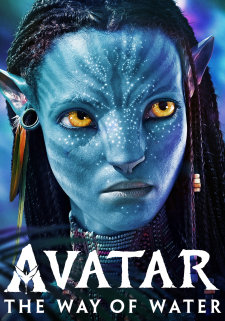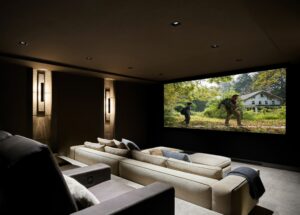Avatar: The Way of Water: Delivers a Sophisticated Sonic Signature with Visceral Visual Flow
A Message from the Cinema Connoisseur
In my eager anticipation of seeing Avatar, The Way Of Water, in a Dolby ATMOS and Dolby Vision equipped cinema, I discovered an interview with the entire sound team conducted by Dolby Institute, to be fun and informative. Ratcheting up my already, over-the-top, excitement to a near intolerable level for my poor wife. You see, there aren’t any ATMOS and Dolby Vision equipped cinemas on Maui, so the viewing was to be inserted into a vacation. Geek mode in full swing, I carefully selected a viewing time that had perfect seats available, naturally everyone else would accommodate my timing and shuffle their schedule…
The interview spoke to the creativity, care and passion the team of world class artists poured into creating a sonic universe that is Pandora and more specifically, Metkayina, where the Sully and his Pandoran clan find themselves adapting to a new culture and environment, while the rest of us, the audience, are similarly discovering, the drama as well as the sights and sounds of their new home. I loved the insights. A personal favorite, as a Maui resident who is blessed to share aquatic space with humpback whales, was how the language and voice of Payakan, the Tulkan whale like creature, took inspiration from these amazing telestial creatures. Delicious tidbits like this make the anticipation and enjoyment of this seventh art even greater.
This month’s Cinema Sommelier includes a rich assortment of tantalizing insights to heighten your enjoyment. Have no fear if you missed the theatrical release or experienced it without the benefit of ATMOS. While the number of such superbly outfitted public theaters remains small, many more have and can acquire such a remarkable experience in a well-engineered and designed private cinema equipped with a Kaleidescape Movie Server. Again and again.
Kaleidescape Curator Notes

James Cameron created another game-changing audiovisual masterpiece with Avatar: The Way of Water. Just as he wowed audiences 14 years ago by demonstrating what a modern 3D movie could look like with the first Avatar, the sequel sets a new standard for creating believable digital characters inside realistic fantasy worlds.
Cameron achieves his new benchmark film by using new techniques and innovative technologies to marry motion-capture movements of real actors with digitally created characters and combine those performances with virtual scenery that looks incredibly authentic and a soundscape that feels natural.
“Working alongside Gary Summers and Chris Boyes allowed for a strong collaboration, with each working to ensure we were able to create space and dynamics so important in any soundtrack…. I feel this is a signature of James Cameron’s movies. ‘Clarity is King,’ echoed in my head as we worked solidly on every aspect of the track. Jim would constantly be focused on what is important—the story!
Michael Hedges
‘Focus on what’s working and what needs to go!’
This is Cameron’s complete vision of Pandora and totally reflects every detail of how it should be seen and heard – a true masterpiece!”
Preferred Pairing
If the Na’vi were themselves to pick a category of wine, from Earth, they would definitely select something biodynamic. The name refers to a style of farming practices that emphasize an all-natural approach to agriculture, while tying in a mystical, spiritual belief in planting and harvesting in concert with astrological movements. Biodynamic practitioners avoid most pesticides and synthetic fertilizers for organic composts and view their land as a holistic ecosystem—with diversity of insects, animals and plants all contributing to a healthier environment.
In terms of the type of wine, Avatar: The Way of Water’s lush, tropical setting calls for a “new world” Sauvignon Blanc. One of the early proponents for biodynamic practices in California was Sonoma-based Benziger. The company’s 2022 Paradiso de Maria Sauvignon Blanc was made from biodynamically farmed grapes and mixes flavors of Meyer lemon, lime, passion fruit and grapefruit with zesty acidity. It is a perfect sipper for this epic blockbuster.
When to Consume: While Sauvignon Blanc is a light wine, it is best to pace yourself with a movie that is more than three hours long.
When to Consume:
While Sauvignon Blanc is a light wine, it is best to pace yourself with a movie that is more than three hours long.
Body of Work

Avatar: The Way of Water brings audiences back to Pandora for another epic adventure, this time showing us a new region of the planet that is dominated by a seafaring tribe. The movie delivers incredible scenery and intense action sequences.
Avatar follows a similar plot structure to the first movie: the Na’vi have to protect their planet from humans who want to exploit it for its natural resources. While most of the main characters are familiar, half of the movie takes place with the Metkayina clan, an island-based community that has adapted to life spent in the water. This allows Cameron to provide audiences with a new alien world to explore, through the eyes of the protagonists, who are trying to learn this new group’s lifestyle and make it their home.
What makes Avatar: The Way of Water stand out from other big-budget epic sci-fi movies is the incredible amount of realistic detail in every scene. Take the hair of Na’vi: individual strands stand out for their lifelike appearance and movement, both in the air and the water. This effect was a big change from the original film, according to an interview Senior Visual Effects Supervisor Eric Saindon gave to the A.V. Club:
“On the first film, the hair for Neytiri and Jake was solved as big strips of cloth…But in this film, every individual hair on their heads was solved, and colliding with one another, colliding with the water, interacting with the water, interacting with other characters. It is things like that, all those small details that people won’t even notice that are different, that make all the difference in the world.”
Another interesting aspect of this film was how they shot the actors. With this type of movie that relies heavily on CGI, it is not unusual for actors to have their performances recorded while standing in an empty studio, talking to an inanimate object that will later be transformed into a digital character. For his second Avatar movie, Cameron had the ensemble together for their scenes, regardless of whether their physical appearance in the movie would be created through motion capture or used live.
As a result, Cameron seems to have solved one of the issues that can plague a heavily digitized movie: the over- or under-acting by performers attempting to conjure up an authentic emotional scene while surrounded by green screens and speaking to a tennis ball with eyes, as a placeholder.
“It’s one of the biggest changes in the acting profession since the advent of talkies,” the Wall Street Journal noted in a 2015 article, Actors and Visual Effects: How to Behave on a Green Screen. “Actors must constantly summon dramatic performances while looking at scenery and co-stars that aren’t there.”
In the transition from silent films to movies with sound, the modern technology required actors to be less dramatic with their physical movements, as the addition of sound allowed them to convey more realistic expressions. Even though we are two decades into the CGI era of movies, many actors have been outspoken on the difficulty of delivering believable performances in this unfamiliar environment. Cameron’s approach to this method parallels the transition from silent movies to sound and could have far-reaching impacts on the digital age of moviemaking.
From an audio perspective, Cameron’s use of Dolby Atmos allows him to bring audiences into several immersive scenes, including a forest firefight with bullets whizzing in all directions, an amphibious battle between helicopter-like vehicles and whale-like creatures, and many quieter moments where Pandora’s nature shines.
The stunning visual effects, enhanced by high dynamic range (HDR) and audience-encompassing object-based audio make Avatar: The Way of Water the new standard as a reference film, the kind that AV companies and retailers will use to demo their equipment for the next decade.
What better way to show off your own system to friends and family than with a few select scenes from Avatar: The Way of Water?
Tasting Notes
Like fine wine, there are always moments that shine in a movie, scenes that stand out in our AV sensory palate. For Avatar: The Way of Water we asked Kevin Cook, managing partner at Amplified Lifestyles, to walk through the demo scenes in this movie to share some dealer “demo notes” and personal insights.
He often uses the following scenes to showcase the latest AV gear, ensuring the technology delivers an optimized performance.
A Raiding Party: 00:12:28.122 – 00:15:39.43

Accompanied by jungle drums and an anthemic orchestral chorale of war, the Na’vi raiding party swarms through the Pandoran canopy, as lush and vibrant as it was when we last visited. We are immediately enveloped in the familiar sounds of banshees in flight, overhead, and all around. The precise Dolby Atmos mix delivers the sense of air moving as the wings waft through the sky layered nicely with Na’vi war cries. We are back on Pandora! As an alien supply train comes into frame, these familiar sounds are overwhelmed by a utility escort aircraft, hovering above us, to defend the train’s cargo against the imminent attack by the Na’vi.
The soundscape then shifts to the monorail just as the attack commences, explosively resulting in the raw squeal of metal train wheels on track and the moving, crashing rumble of a wreck. The transition from moving audio is grounded by the tremendous bass of the crash. This scene has so much dynamic range, it is an ideal demo to show what properly configured overhead speakers and subwoofers can sonically achieve.
The first action sequence of the movie, the scene is rich in audio and video goodies. The sound blends in harmony with the vivid colors of the Na’vi, and the lush jungle that becomes ensconced in fiery explosions, an effect used in many movies, often criticized as lackluster before the introduction of HDR. Artistically generated with CGI, it is hard to appreciate the deep contrast and color complements of these effects without the high-quality 4K HDR playback the Kaleidescape platform delivers.
More impressive, even without 3D playback, the perceptible “depth” of the picture is stunning on any 4K TV or projector. The effective shading allows us to appreciate minute details like the Na’vi’s hair, effervescent skin and even the fire embers floating around as the battle commences. The scene does not disappoint and sets the stage that we are in store for something spectacular.
“In the soundtrack, we didn’t just want to revisit existing soundscapes but create a whole new sound experience with details that take you into the world of Avatars with CGI—extending the reality so you believe these characters are real!”
Michael Hedges
An Old Enemy Returns: 00:36:42.700 – 00:40:54.53

In this scene, Pandora’s rainforest sights and sounds are rendered convincingly as rain falls on the native hostages and their captors. As the raindrops fall from overhead, even more effective, was the underlying pulsing and seeming “creature” calls of Neytiri as she alerts the captives that help is on the way. The positioning of the calls is key, and the ambience of the sound is accurately rendered.
Like a musical composition, the subtle sounds bring a dramatic effect, setting the stage for the attack. The gunfire and tracers were both visually and audibly realistic, drawing you deeper into the scene, accompanied by detailed sound objects of splintering wood and bullets that fly past your head throughout the battle. In contrast, the personal drama of revenge is signaled, as Neytiri’s arrow slices through the air, targeting Quaritch, with audible conviction.
The scene culminates in a chase action sequence that delivers brilliant visual artistry only enhanced once again by HDR. The well-woven drama, action, imagery and sound design will have anyone gripping the armrests and really drawn into this scene.
“Coming back to Pandora gave us an extraordinary opportunity to re-create the native sounds for the incredibly lush, detailed forests, teaming with life above and below the surfaces of Pandora.”
Michael Hedges
Kiri Lights the Way: 02:52:01.978 – 02:55:48.78

Ultimately, cinema is storytelling. In this scene, the story is Kiri, an enigmatic hero who employs her connection with Eywa and unique ability to bond with Pandora’s creatures to save her family. Jake and Lo’ak are trapped deep in the sunken vessel, quickly running out of air and time, while Neytiri and Tuk are likewise confined but a distance away. As she connects and directs a school of bioluminescent sea creatures, the score and subtle aquatic “atmospheric” sounds place us emotionally and environmentally. As she sends her minions on their mission, you may notice the disparate paths taken, and they spread like stars illuminating the path with twinkle-like music that envelops the room.
Suddenly, we find ourselves in the chamber with Jake and Lo’ak as the roles are reversed and the young son teaches the father. Kaleidescape’s reference-quality video lets the HDR shine with impossible detail as the surface of the water splits the scene above and below. It feels like we are seeing colors never before seen as the HDR illuminates the yellow of the sea creature and the blues and greens in this magical underwater sequence.
Sonically too, the ambience of the shrinking air space contrasts with the transmissive quality of Lo’ak’s voice from under water. Notice the artistic liberty as his voice changes its quality when our view changes to follow Kiri as she is led to her sister and mother’s aid. The escape of father and son, mother and daughters, is accompanied by a dramatic passage of musical score and an underwater soundscape that convinces us we now understand…the way of water.
“On set, the challenges ranged from building head rigs for each actor, to pressurizing microphone capsules to work at various depths, and being able to survive to capture the air intake upon surfacing after seven minutes of dive time. Spectacular!”
Michael Hedges
Vintner’s View

Every exceptional wine review brings a little something extra to the table, be it personal insights from the master winemaker or the team of vintners who helped produce the final product. The artistry that goes into moviemaking deserves the same recognition. In this section of the review, we reference “film vintners” to bring some added texture to what went into creating the artistic flavors of the film. We asked two-time Oscar winner and Oscar-nominated re-recording mixer of Avatar: The Way of Water, Michael Hedges, to provide some insights.
“Returning to Pandora took on a whole new meaning for us to deliver the sonic signature and sound experience to match the stunning imagery and the technical masterpiece that James Cameron created for Avatar: The Way of Water. From the first day on set, James focused on every detail of what he wanted from every scene and from every character. Every breath, effort, line of dialogue, and reactional gasp was fundamental in creating the realism that so permeates every aspect of the film.”
Michael Hedges





